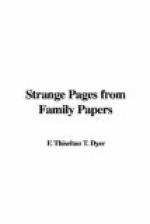“Proud Chief of Mar, thou shalt be raised still higher, until thou sittest in the place of the King. Thou shalt rule and destroy, and thy work shall be after thy name, but thy work shall be the emblem of thy house, and shall teach mankind that he who cruelly and haughtily raiseth himself upon the ruins of the holy cannot prosper. Thy work shall be cursed, and shall never be finished. But thou shalt have riches and greatness, and shall be true to thy sovereign, and shalt raise his banner in the field of blood. Then, when thou seemest to be highest, when thy power is mightiest, then shall come thy fall; low shall be thy head amongst the nobles of the people. Deep shall be thy moan among the children of dool (sorrow). Thy lands shall be given to the stranger, and thy titles shall lie among the dead. The branch that springs from thee shall see his dwelling burnt, in which a King is nursed—his wife a sacrifice in that same flame; his children numerous, but of little honour; and three born and grown who shall never see the light. Yet shall thine ancient tower stand; for the brave and the true cannot be wholly forsaken. Thou, proud head and daggered hand, must dree thy weird, until horses shall be stabled in thy hall, and a weaver shall throw his shuttle in thy chamber of state. Thine ancient tower—a woman’s dower—shall be a ruin and a beacon, until an ash sapling shall spring from its topmost stone. Then shall thy sorrows be ended, and the sunshine of royalty shall beam on thee once more. Thine honours shall be restored; the kiss of peace shall be given to thy Countess, though she seek it not, and the days of peace shall return to thee and thine. The line of Mar shall be broken; but not until its honours are doubled, and its doom is ended.”
In support of this strange curse, it may be noted that the Earl of 1571 was raised to be Regent of Scotland, and guardian of James VI. As Regent, he commanded the destruction of Cambuskenneth Abbey, and took its stones to build himself a palace at Stirling, which never advanced farther than the facade, which has been popularly designated “Marr’s Work.”
In the year 1715, the Earl of Mar raised the banner of his Sovereign, the Chevalier James Stuart, son of James the Second, or Seventh. He was defeated at the battle of Sheriff-Muir, his title being forfeited, and his lands of Mar confiscated and sold by the Government to the Earl of Fife. His grandson and representative, John Francis, lived at Alloa Tower (which had been for some time the abode of James VI. as an infant) where, a fire breaking out in one of the rooms, Mrs. Erskine was burnt, and died, leaving, beside others, three children who were born blind, and who all lived to old age.
But this remarkable curse was to be further fulfilled, for at the commencement of the present century, upon the alarm of the French invasion, a troop of the cavalry and yeomen of the district took possession of the tower, and for a week fifty horses were stabled in its lordly hall; and in the year 1810, a party of visitors were surprised to find a weaver plying his loom in the grand old Chamber of State. Between the years 1815 and 1820, an ash sapling might be seen in the topmost stone, and many of those who “clasped it in their hands wondered if it really were the twig of destiny, and if they should ever live to see the prophecy fulfilled.”




